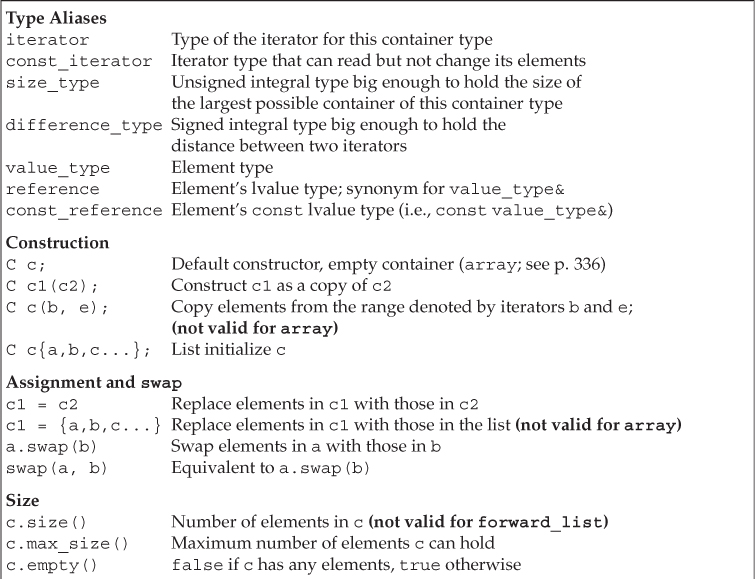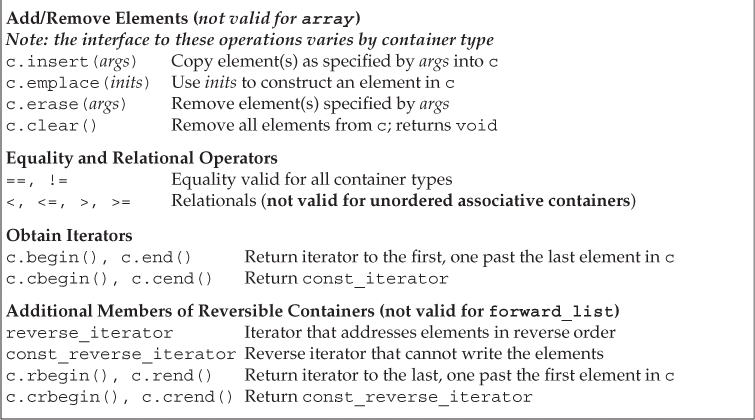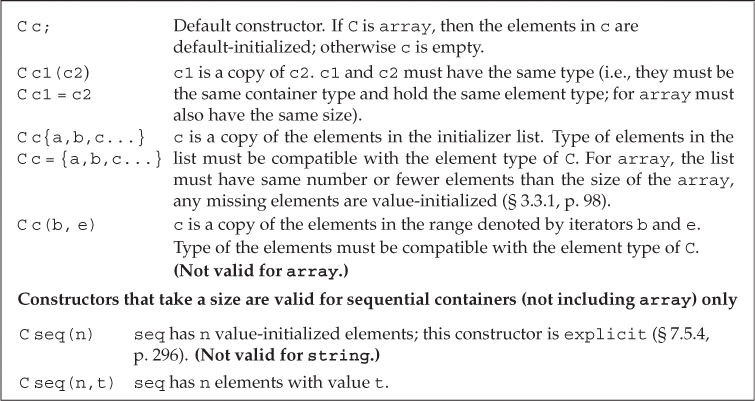 9.2. Container Library Overview
by Barbara E. Moo, Josée Lajoie, Stanley B. Lippman
C++ Primer, Fifth Edition
9.2. Container Library Overview
by Barbara E. Moo, Josée Lajoie, Stanley B. Lippman
C++ Primer, Fifth Edition
- Title Page
- Copyright Page
- Dedication Page
- Contents
- New Features in C++11
- Preface
- Chapter 1. Getting Started
- Part I. The Basics
- Contents
- Chapter 2. Variables and Basic Types
- Chapter 3. Strings, Vectors, and Arrays
- Chapter 4. Expressions
- Contents
- 4.1. Fundamentals
- 4.2. Arithmetic Operators
- 4.3. Logical and Relational Operators
- 4.4. Assignment Operators
- 4.5. Increment and Decrement Operators
- 4.6. The Member Access Operators
- 4.7. The Conditional Operator
- 4.8. The Bitwise Operators
- 4.9. The sizeof Operator
- 4.10. Comma Operator
- 4.11. Type Conversions
- 4.12. Operator Precedence Table
- Chapter Summary
- Defined Terms
- Chapter 5. Statements
- Chapter 6. Functions
- Chapter 7. Classes
- Part II. The C++ Library
- Contents
- Chapter 8. The IO Library
- Chapter 9. Sequential Containers
- Chapter 10. Generic Algorithms
- Chapter 11. Associative Containers
- Chapter 12. Dynamic Memory
- Part III. Tools for Class Authors
- Contents
- Chapter 13. Copy Control
- Chapter 14. Overloaded Operations and Conversions
- Contents
- 14.1. Basic Concepts
- 14.2. Input and Output Operators
- 14.3. Arithmetic and Relational Operators
- 14.4. Assignment Operators
- 14.5. Subscript Operator
- 14.6. Increment and Decrement Operators
- 14.7. Member Access Operators
- 14.8. Function-Call Operator
- 14.9. Overloading, Conversions, and Operators
- Chapter Summary
- Defined Terms
- Chapter 15. Object-Oriented Programming
- Contents
- 15.1. OOP: An Overview
- 15.2. Defining Base and Derived Classes
- 15.3. Virtual Functions
- 15.4. Abstract Base Classes
- 15.5. Access Control and Inheritance
- 15.6. Class Scope under Inheritance
- 15.7. Constructors and Copy Control
- 15.8. Containers and Inheritance
- 15.9. Text Queries Revisited
- Chapter Summary
- Defined Terms
- Chapter 16. Templates and Generic Programming
- Part IV. Advanced Topics
- Contents
- Chapter 17. Specialized Library Facilities
- Chapter 18. Tools for Large Programs
- Chapter 19. Specialized Tools and Techniques
- Appendix A. The Library
- Contents
- A.1. Library Names and Headers
- A.2. A Brief Tour of the Algorithms
- A.2.1. Algorithms to Find an Object
- A.2.2. Other Read-Only Algorithms
- A.2.3. Binary Search Algorithms
- A.2.4. Algorithms That Write Container Elements
- A.2.5. Partitioning and Sorting Algorithms
- A.2.6. General Reordering Operations
- A.2.7. Permutation Algorithms
- A.2.8. Set Algorithms for Sorted Sequences
- A.2.9. Minimum and Maximum Values
- A.2.10. Numeric Algorithms
- A.3. Random Numbers
- Index
- Add Pages
9.2. Container Library Overview
The operations on the container types form a kind of hierarchy:
• Some operations (Table 9.2 (p. 330)) are provided by all container types.
Table 9.2. Container Operations


• Other operations are specific to the sequential (Table 9.3 (p. 335)), the associative (Table 11.7 (p. 438)), or the unordered (Table 11.8 (p. 445)) containers.
Table 9.3. Defining and Initializing Containers

• Still others are common to only a smaller subset of the containers.
In this section, we’ll cover aspects common to all of the containers. The remainder of this chapter will then focus solely on sequential containers; we’ll cover operations specific to the associative containers in Chapter 11.
In general, each container is defined in a header file with the same name as the type. That is, deque is in the deque header, list in the list header, and so on. The containers are class templates (§ 3.3, p. 96). As with vectors, we must supply additional information to generate a particular container type. For most, but not all, of the containers, the information we must supply is the element type:
list<Sales_data> // list that holds Sales_data objects
deque<double> // deque that holds doubles
-
No Comment